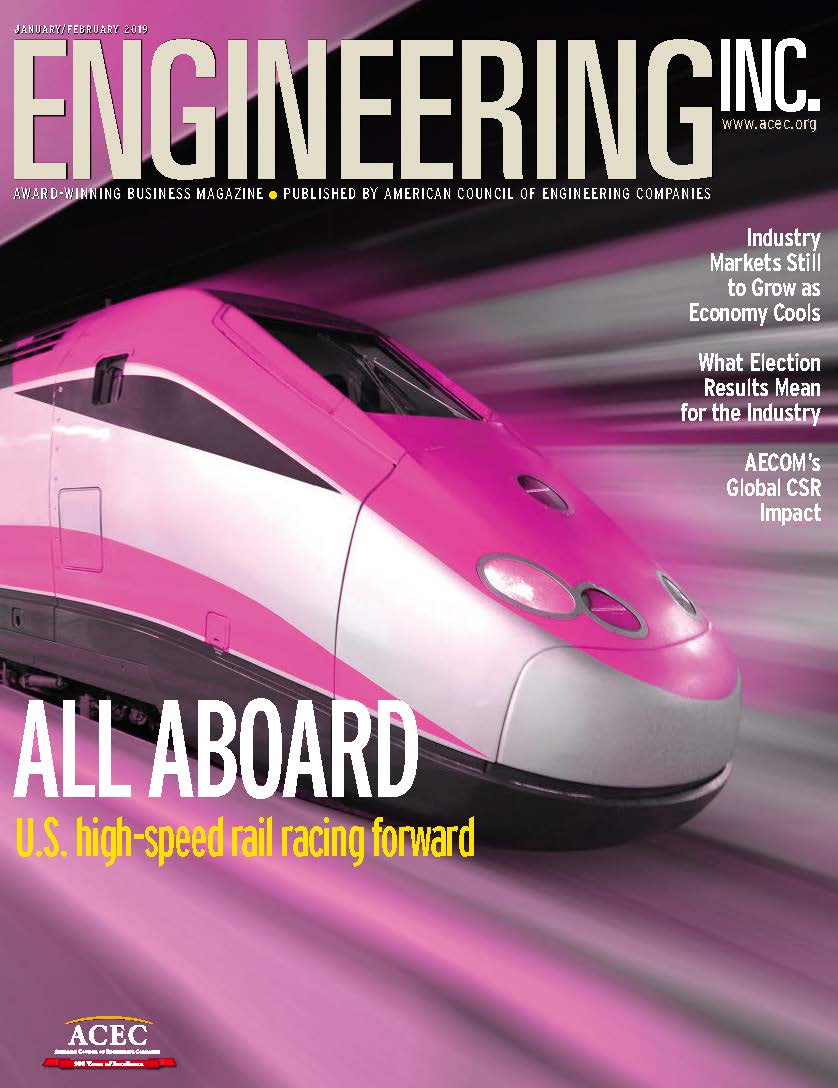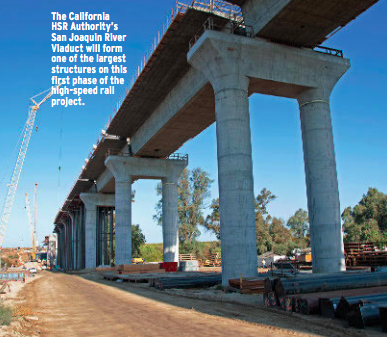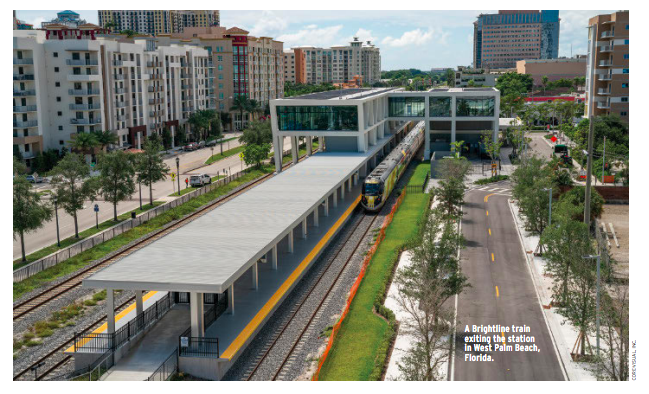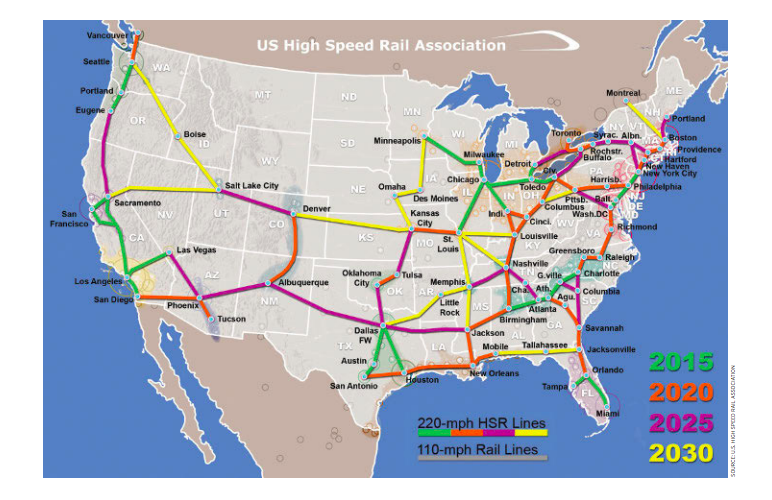AMERICAN COUNCIL OF ENGINEERING COMPANIES (ACEC)
Overcoming viability concerns and political partisanship, the progress of high-speed rail in the U.S. is picking up much-needed steam.
High-speed rail in the United States came of age in 2018. Over the past three decades, high-speed rail (HSR) made the painfully slow transformation from pipe dream to the next big thing. But is it more like the train to nowhere?
 Even as late as 2017, with billions of dollars of infrastructure under construction in California’s Central Valley, industry analysts continued to question the viability of HSR in the U.S. However, the private sector has embraced the concept.
Even as late as 2017, with billions of dollars of infrastructure under construction in California’s Central Valley, industry analysts continued to question the viability of HSR in the U.S. However, the private sector has embraced the concept.
In 2018, privately owned Brightline started operating higher speed trains (78 mph) in Florida between Fort Lauderdale and West Palm Beach, eventually extending the line to Miami in May. Additionally, the U.S. investment firm Global Infrastructure Partners purchased private Italian HSR operator Italo – Nuovo Trasporto Viaggiatori S.p.A., in April, creating the possibility for an investor market in HSR projects.
Last summer, Microsoft helped to fund a feasibility study for the Cascadia HSR network in the Pacific Northwest, citing the potential positive economic impact for the region. In September 2018, Brightline again made news with its purchase of Xpress West, a proposed HSR line connecting Las Vegas to southern California. Also, Texas Central Partners secured a $300 million loan to move ahead with plans to connect Dallas and Houston and contracted with global firms to build and operate the HSR line.
Public HSR projects are also showing signs of progress. The California High Speed Rail Authority announced that it has enough funding to complete the first phase of its network; transportation leaders in Oregon, Washington and British Columbia are moving forward with the Cascadia network; and Illinois completed the initial feasibility study for a HSR line connecting Chicago to Springfield, Illinois.
“The past few months have been a game-changer,” says Andy Kunz, president and CEO of the U.S. High Speed Rail Association (USHSRA). “We have arrived at a new day.”
GLOBAL EXPANSION
The first HSR line, which Japan introduced in 1964, connected Tokyo and Osaka with a train that operated at 130 mph. Today the line is the busiest in the world, transporting more than 150 million riders a year on trains traveling at up to 200 mph.
European countries soon followed suit, along with Russia in 1974, England in 1976 and France in 1981. The European HSR network connects 10 countries with trains operating at close to 200 mph, and currently, there are plans to expand the system from Turkey to Norway.
However, no country has taken to HSR quite like China. Since introducing its first HSR line in 2007, China has built more than 15,000 miles of HSR rail and is home to the world’s only magnetic-levitation (maglev) train, which connects the Shanghai Pudong Airport to the Longyang Road Metro Station in the Pudong New Area located near the Shanghai city center, at speeds up to 268 mph. China recently announced that it is testing a new maglev train that could hit speeds of 370 mph, and the country is working on a train that could travel up to 621 mph.
During all this activity, the U.S. has lagged noticeably behind. The nation’s fastest system is the Acela Express Train, which Amtrak operates between Boston and Washington, D.C. The Acela Express can reach 156 mph, but dated infrastructure and corridor congestion keep the train’s average speed to just 70 mph over the 457-mile route.
“We need to advance our program if we want to keep up with the global market,” says Julie D’Orazio, national market leader for transit and rail services at WSP USA, which is the program manager for the California HSR project.
After the 2007 financial crisis, the Obama administration made $8 billion available for HSR development. Almost immediately, however, publicly funded HSR projects became a litmus test for political affiliations, with the Republican governors of Florida and Ohio refusing to accept the funding.
“It became a wedge issue, defining Republican versus Democrat,” says Peter Gertler, senior vice president at HNTB, which is working on the California HSR and is the program manager for Brightline. “That has taken the focus away from the potential of these programs. California’s project is supported by a majority of residents, but it has become a political football in Washington, D.C.”
GOLDEN STATE MEGAPROJECT
Because of the huge size and ambition, the California HSR project has dominated conversation in the sector for the past 10 years.
“It has been a very aggressive project and a very complicated project, given the number of decision makers, stakeholders and interested parties in California,” Gertler says.
 As can be expected on unique megaprojects, cost overruns and delays have multiplied. Originally projected to cost $40 billion, the latest estimate tops $77 billion. The completion schedule keeps extending into the distant future. Trains will not start operating along the 119-mile first segment from Bakersfield to Madera until 2026; the connection to San Francisco will open in 2029; and it will be 2033 before trains make the trip from the Bay Area to Los Angeles.
As can be expected on unique megaprojects, cost overruns and delays have multiplied. Originally projected to cost $40 billion, the latest estimate tops $77 billion. The completion schedule keeps extending into the distant future. Trains will not start operating along the 119-mile first segment from Bakersfield to Madera until 2026; the connection to San Francisco will open in 2029; and it will be 2033 before trains make the trip from the Bay Area to Los Angeles.
“The timeline for getting the project built is longer than most political office timelines,” says USHSRA’s Kunz. California Gov. Jerry Brown was a strong HSR proponent, but he did not run for re-election. Gov.-elect Gavin Newsom offered lukewarm support for the project during the campaign. The Republican candidate, John Cox, opposed the HSR program, calling it “the train to nowhere.”
“Every project is vulnerable until the trains are running,” says Kunz.
The biggest engineering challenge for the California HSR line will be traversing three mountain ranges.
“We have to cross the Coastal Range in the Pacheco Pass area, the Tehachapi Mountains south of Bakersfield and the San Gabriel Mountains between Palmdale and Burbank,” says Scott Jarvis, chief engineer of the California High Speed Rail Authority.
Current alignments call for between 45 and 50 miles of tunnels, ranging in length from several thousand feet to more than 20 miles, some of which could be more than 2,000 feet underground.
Even more difficult is securing a steady source of project funding. In 2008, the California Legislature provided $9.5 billion for the project, and in 2009 and 2010 the federal government provided $6.25 billion. Until now the project has been operating on a pay-as-you-go basis, but, according to Jarvis, the completion of the Bakersfield-Madera segment will exhaust those funds.
Beginning in 2015, the authority began receiving 25 percent of the revenue from the state’s cap-and-trade program, around $1.2 billion to date. In 2017, the Legislature extended that allocation through 2030, which will provide an additional $7.1 billion to $18.4 billion, depending on the robustness of the cap-and-trade program. Those funds will not be enough to finish the project, so the authority has proposed financing its future cap-and-trade proceeds. However, to make the financing work, the state would have to extend the cap-and-trade program through 2050 and provide investor guarantees. The authority hopes to have the program in place by 2021.
In the past, states could count on the federal government to provide a significant percentage of the project funding, but the Trump administration has shown little appetite for HSR. In its current calculations, the authority estimates that the federal share of the project will be only 12 percent although it holds out the possibility that future administrations could provide additional funding.
“The funding environment has changed,” says Gertler. “We used to think of federal support as being the first dollars. Now, they are more likely to be the last dollars.”
PRIVATE SECTOR EMBRACE
According to HSR advocates, the key to generating public funding and political support is getting a system up and running. Given the success of—and subsequent support for—HSR in other countries, they are confident the first operating U.S. line will open the floodgates. However, the long timeline of the California project and the nascent status of the Cascadia and the Midwest systems are problematic.
Therefore, the entry of the private sector may be a game-changer. Although these projects are far more limited in scope and have not yet been true high speed (150-plus mph), the projects may prove that HSR can be a winner in the U.S.
“We are all ll watching very eagerly to see how these services are received,” says D’Orazio, whose company, WSP USA, is working in various capacities on several HSR projects.“ Their success will demonstrate that high-speed rail provides tremendous economic benefits and offers a good rate of return.”
“Now that the private sector is coming into the HSR market, Republicans can be in favor of it,” Kunz adds.
Brightline took approximately 2.75 years and $1.7 billion to build the HSR line connecting Miami and West Palm Beach, Florida, but it had the advantage of already owning the right of way between the two cities. Fortress Investment Group, which owns Brightline, acquired the Florida East Coast Railway in 2007.
“We did not have to deal with the expense and time of acquiring the land,” says Adrian Share, executive vice president of rail infrastructure at Brightline, “but we still had to go through the full environmental process, interfacing with every community along the route.”
 During construction, Brightline upgraded the existing track, added a second track, built several bridges, upgraded all 180 at-grade crossings and installed a new signal system. According to Share, the organization also negotiated a shared use agreement with the freight rail operator using the line, so most freight trains run at night while Brightline uses the corridor during the day.
During construction, Brightline upgraded the existing track, added a second track, built several bridges, upgraded all 180 at-grade crossings and installed a new signal system. According to Share, the organization also negotiated a shared use agreement with the freight rail operator using the line, so most freight trains run at night while Brightline uses the corridor during the day.
Phase 2 of Brightline’s HSR project will extend the service to Orlando International Airport’s new Intermodal Terminal Facility utilizing the existing Florida East Coast Railway corridor and a portion of right of way along the State Road 528 corridor. According to Share, Brightline will operate at speeds up to 110 mph between Cocoa and West Palm Beach and up to 125 mph along the new 40-mile grade-separated railway between Cocoa and Orlando.
Future expansion of the system could extend to Tampa and farther north to Jacksonville.
It is still early, but Share says Brightline is hitting its ridership targets. According to projections, the system must capture just 2 percent of all trips between Miami and Orlando to be successful. In comparison, Amtrak commands about 12 percent of the traffic between New York City and Washington, D.C.
Integral to the Fortress Investment Group’s business model is acquiring and developing the land around the Brightline stations. The company is building more than 800 apartments at the Miami station and close to 300 at the West Palm Beach station in addition to leasing commercial and retail space.
Even as it builds out its Florida network, Brightline has taken its blueprint on the road, purchasing Xpress West, which had gained approval for—but never moved forward with—a 185- mile HSR line between Las Vegas and Victorville, California. According to Share, Brightline will follow the approved plan, which uses the I-15 corridor. Construction is scheduled to start in 2019, and trains are expected to be running by 2022.
According to an article in the Los Angeles Times, Xpress West’s system was estimated to cost $7 billion, but Brightline is aiming to cut that cost in half.
Share says the system—with a Victorville, California, terminus—will be economically viable. Additionally, industry analysts expect the line to eventually extend 60 miles to Palmdale, California, where it could connect to the California HSR system.
“Our vision does not stop here,” Fortress Investment Group co-founder Wes Edens told USA Today. “Our goal is to look at other corridors with similar characteristics—too long to drive, too short to fly.”
Download full article (PDF): Rail Acceleration
Download full January/February issue of Engineering, Inc.
 About the American Council of Engineering Companies
About the American Council of Engineering Companies
www.acec.org
The American Council of Engineering Companies (ACEC) is the voice of America’s engineering industry. Council members – numbering more than 5,000 firms representing more than 500,000 employees throughout the country – are engaged in a wide range of engineering works that propel the nation’s economy, and enhance and safeguard America’s quality of life. These works allow Americans to drink clean water, enjoy a healthy life, take advantage of new technologies, and travel safely and efficiently. The Council’s mission is to contribute to America’s prosperity and welfare by advancing the business interests of member firms.
Tags: ACEC, American Council of Engineering Companies, Brightline, California, Engineering Inc., Florida, High Speed Rail, HSR







 RSS Feed
RSS Feed